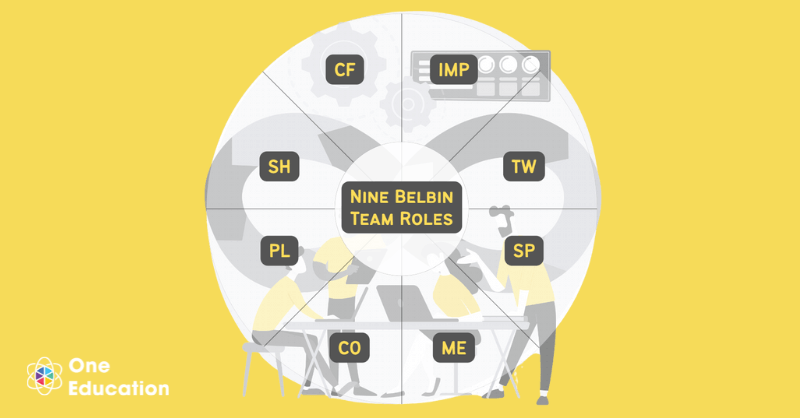According to Meredith Belbin, a team role is the “tendency to behave, contribute, and interact with others in a specific way”. He emphasises team performance through balanced duties. Statistically, over 3 million people have requested the Belbin Team Roles report since its establishment. Individuals, supervisors, teams, and organisations worldwide use these roles to improve their chances of success.
In this blog, we’ll delve into the behaviour of different roles and how they contribute to a team. In addition, we’ll consider whether these roles really work or not.
What is a Team Role?
Each team member has a specific role prioritised and defined by their characteristics. In addition, roles outline responsibilities. A role is not merely a straightforward job assigned to someone without any prior evaluation. In teams, roles play a much bigger part than you may think they do. The definition of Belbin team roles is the tendency of team players to behave, participate, and interact with each other in a particular way.

What is Belbin’s Team Role Theory?
Raymond Meredith Belbin is a British researcher who has pioneered work in team performance. In his team role theory, Belbin concentrated on how roles arise, alter, and interact with other patterns of behaviour across time. After nine-year research on team development and performance with management teams participating in an executive management exercise, he proposed a model.
Following the preliminary research, Belbin proposed eight-team roles in 1981. In addition, he based the categorisation of roles on personality tests, critical thinking ability, and a behavioural checklist. Also, he gave each of the eight-team roles a name and a descriptive term. Finally, Belbin renamed some team responsibilities in 1993 and added a ninth role. Thus begins Belbin’s Team Role Theory after thirty years of research work.
What are the Nine Belbin Team Roles?
Belbin theorised nine exact roles that are crucial to any team. Let’s take a look at the nine Belbin team roles in the following table.
Team Role | Explication |
CF |
|
IMP |
|
TW |
|
SP |
|
ME |
|
CO |
|
PL |
|
SH |
|
RI |
|

What are Belbin’s Team Roles Used For?
An organisation may use Belbin Team Roles to determine people’s behavioural strengths and shortcomings. For example, Belbin team roles help team members have better conversational language.
Belbin team roles would assist you in
- building high-performing teams,
- developing and coaching existing teams,
- and maximising the utilisation of virtual, multi-functional, and project teams.
You can use Belbin team roles to assist managers in transitioning from competent process managers to great people managers. When managers understand their talents and flaws, they may help others utilise their own.
Using Belbin team roles, you can offer suggestions and initiate talks about career choices in individuals. In addition, understanding Belbin Team Roles can assist you in making judgments about whom to hire or promote.
Organisations utilise Belbin team roles to tackle interpersonal and cross-team conflicts. In addition, the roles help team members adapt to the existing or new working relationship.
Finding Your Team’s Balance With Belbin’s Model
You must form balanced teams with a complementary mix of personalities and skills to complete your task goals. In smaller teams, each member may need to take on multiple roles for the team to get the best outcomes. Especially take statements of the people on your team, their personalities, and their abilities. What can each team member offer to the table? In addition, what roles could be best for them? For example, assume your team consists of the following five individuals.
|
|
|
|
|

These five personalities have the potential to fill all nine of Belbin’s team roles.
Harry |
|
Olivia |
|
Florence |
|
Hugo |
|
Vijaya |
|
A team with all the necessary talents and assets will need a crafty manager to successfully produce exceptional outcomes. For example, a smart manager would opt to give an introverted plant like Hugo a space apart from the group to develop his ideas rather than submitting his work to critical thinkers like Shaper Harry and Monitor-Evaluator Florence before his creative conceptions are wholly realised.
You should identify which team members need what. As a result, you will find your team’s balance with Belbin’s Model.
What are the Belbin Action-Oriented Roles?
The action-oriented roles primarily focus on pushing the team to perform better. The three action-oriented roles are Shaper, Implementer, and Completer-Finisher.
Shaper (SH)
Shapers are goal-oriented individuals with great enthusiasm and determination. Besides encouraging themselves and others to move forward, they have a solid drive to conquer problems.

In addition, they are typically forceful and have directive managerial styles. Shapers are highly competitive and seek to win. Their daring and assertive leadership style produces outcomes. Therefore, they advance their career in organisations sooner than others.
SHs don’t possess interpersonal sensibilities. As a result, they might be rude and argumentative.
Implementer (IMP)
You can distinguish implementers by their practical approach and superior degrees of self-control and discipline. They are willing to work hard to do the tasks systematically.

In addition, they are usually devoted to the organisation. Therefore, they are likely to be perceived as people who do not pursue personal agendas and self-interest.
IMPs may resist new methods of doing things, especially if they deem the idea as radical or impractical.
Completer-Finisher (CF)
Completer Finishers possess a high level of precision. They are continuously in pursuit of perfection and correcting mistakes. CFs are more introverted than most people and require less external stimulation. As a result, you can rely on the CF to meet deadlines.

On the other hand, the combination of striving for perfection and meeting deadlines frequently causes anxiety. Therefore, CFs are likely to be hesitant to trust others to perform tasks to their rigorous expectations.
What are the Belbin People-Oriented Roles?
People-oriented roles bring together people and ideas. They are skilled at interacting with others. In addition, they are capable of drawing out ideas from others and networking with people. Coordinator, Team Worker, and Resource Investigator are the three sorts of people-oriented roles.
Coordinator (CO)
Coordinators are predisposed to assist others in working toward common goals. They delegate tasks efficiently because they are mature, trusting, and assured. In addition, they quickly identify individual abilities and use them to achieve group goals in interpersonal relationships. While COs are not always the brightest or most senior team members, they have a broad outlook and perspective.

However, COs’ realistic goal orientation might often lead to them manipulating others to achieve their personal goals. In addition, COs and Shapers may sometimes clash due to their opposing management methods.
Team Worker (TW)
Team Workers have a pleasant and social demeanour. They are often supportive and caring about others. In addition, they have a high level of adaptability to varied settings and people. TWs are insightful, diplomatic, and sympathetic people who make excellent listeners. Therefore, they are well-liked by their co-workers because of these characteristics.

However, when presented with difficult solo decisions, their concern for creating peace and avoiding confrontation might cause them to be indecisive.
Resource Investigator (RI)
Resource investigators are engaging extroverts. They are excellent communicators both inside and outside the organisation. In addition, they are natural negotiators who excel at discovering new opportunities and making new contacts.
RIs are efficient at picking up and promoting other people’s ideas. Also, they are skilled at determining what is available and from whom. Finally, due to their outgoing character, they frequently receive a warm welcome from others.

RIs are generally laid-back people with a high sense of curiosity and an eagerness to see the possibilities in anything new. Unless others constantly stimulate them, their excitement will quickly fade.
What are the Belbin Thought-Oriented Roles?
Thought-oriented roles are experts in research and invention. They can provide in-depth analysis. In addition, their mastery of a specific topic contributes a lot to teamwork. There are three thought-oriented roles- Plant, Monitor-Evaluator, and Specialist.
Plant (PL)
Plants are incredibly inventive. They serve as a source of fresh ideas to fuel innovation. They usually prefer to work alone, apart from the rest of the team, to fuel their imagination. In addition, they often work in unconventional ways. PLs are introverted and sensitive to criticism and appreciation. Their ideas are frequently bold. Therefore, the ideas may lack realistic constraints.

PLs are self-sufficient and regarded as intelligent due to their unique and extreme viewpoint. However, they don’t always communicate well and provide their thoughts in a realistic and meaningful framework.
Monitor-Evaluator (Me)
Monitor Evaluators are serious-minded, sensible people. They are immune to becoming overly enthused. In addition, they are likely to be slow to make decisions, preferring to deliberate thoroughly. On top of that, MEs usually have a robust critical thinking capacity. Therefore, they are capable of making sound decisions that take into account all relevant factors.

A good ME is unlikely to make rash or intuitive decisions. When weighing options, they use facts and reasoning rather than emotions. However, others may frequently view MEs as too critical, slow, and monotonous.
Specialist (SP)
Specialists are distinguished by their enthusiasm for learning. They consider learning and knowledge accumulation as the primary reason for their existence. In addition, their discrete and steadfast pursuit of this goal serves as their direct drive. As a result, colleagues are likely to recognise the SP as an expert to whom they can turn for advice and assistance.

However, SPs often want to avoid impromptu meetings and discussions, as well as those of a social nature. When challenged regarding the validity of their knowledge or field of expertise, they may appear to be obstinate.
How to Use Meredith Belbin’s Team Roles?
You can resolve disagreements among colleagues by knowing Belbin’s Team Roles model. In addition, you will understand and appreciate everyone’s contributions. Finally, you can use the Team Role Circle to apply your report once you’ve received it. It consists of four steps.
1. If you have a large group, divide them into “teams” of five or six people. Avoid splitting up a small group if possible.
2. First, instruct each team to create a circle. Next, divide it into nine equal portions for each of Belbin’s team roles. Finally, write their names in the segments corresponding to their top two responsibilities.
3. Encourage team members to examine their strengths and weaknesses. To do that, ask them to name five primary areas where they believe their strengths and shortcomings lie. In addition, learn how these strengths or weaknesses match, overlap, or contrast with those of their co-workers.
4. Request that your team develop three action items based on its findings. In addition, you should aim to assist the team in performing more successfully.
How Accurate are Belbin’s Team Roles?
Many of the roles established by Belbin have received empirical validation. For example, 27 studies have empirically or conceptually tested Belbin’s team role model. Five of them have produced negative findings.
For example, some of them have shown concerns about potential gender bias. Studies found that males outperformed females in Chair, Shaper, and Plant roles. In contrast, females outperformed males in the role of Team Worker. However, these impacts might be related to BTRSPI response patterns instead of flaws in Belbin’s theory.

In addition, experts have extensively researched Belbin’s theory in terms of performance. High-performing teams, according to Belbin, are ones in which all nine team functions are present. As a result, balanced teams are more likely to succeed.
A researcher named Barbara Senior examined 11 management teams to evaluate this premise. She established that indicators of team role balance were connected to team effectiveness. Other researchers confirmed similar findings, demonstrating that a team of different roles outperformed a team primarily of Shapers.
Therefore, you may consider Belbin’s Team Roles as reasonably accurate. Regardless of its questionable shortcomings, the theory is crucial to team management.
How to Use the Belbin Model in the Workplace?
Use Belbin Model with the following approaches.
- Learn about behavioural tendencies in the workplace.
- Observers should provide non-defensive feedback.
- Improve the alignment between how you view yourself and how others see you.
- Discover your hidden abilities and strengths.
- See the dynamics and composition of a team quickly.
- Improve team performance by knowing how you divide the roles among team members.
- Lean on your strengths to be more efficient.
To utilise Belbin Team Roles and build expertise in team management, take a look at our Team Management Course.
How can Team Roles Improve Performance in the Workplace?
Some Belbin Team Roles are more “high-profile”. In contrast, some roles may shout louder than others. However, you must understand that each behaviour is critical to the team’s success from start to end. Creating a more-balanced team is the key.
For example, a team lacking the Plant role struggles to spark the initial idea. However, terrible ideas mask good ideas when there are too many Plants on a team. In addition, team managers give non-starters too much attention.
Similarly, without a Shaper, the team flounders with missing deadlines. With too many Shapers, infighting erupts and morales lower. So, creating a more-balanced team requires the methodical use of all the team roles. You must use the Belbin Model accurately, as suggested.

How can Leaders and Managers Use Belbin’s Team Roles to Improve Performance?
Leaders and managers can use Belbin’s Team Roles to better understand and develop team dynamics. Managers will successfully improve team performance by examining the following things:
- Identification of behavioural strengths and shortcomings
- Individual team member growth
- Improvements of internal communication
- Collaboration amongst multi-functional teams
- Management advancement
- Leadership advancement
- Better recruitment decision-making
- Conflict resolution
- Employee involvement
Limitations of Belbin’s Team Roles
You’ve discovered that using Belbin Team Roles can help you increase your team’s performance. However, don’t assume you can apply Belbin Team Role Theory in every case. It does have certain limits.
Designed Specifically for Groups
Completing a Belbin Report can provide important information on three levels:
- personal development,
- team development,
- and culture transformation.
You can utilise the report to assess your or your employees’ teamwork habits. Utilisation can be one-on-one or one-to-many. However, it always represents how you work with others.
Intended for the Workplace
When applied in a work situation, Belbin Team Role Theory can be utilised to predict team performance. The substantial study that underpins the Belbin Report only pertains to using Belbin at work, not at home or in social settings.
Assesses Behaviours Rather Than Personalities
A person cannot be judged solely on team-related behaviours. A person’s entirety also includes a variety of other aspects, such as personality. Belbin Report is not a psychometric instrument. Therefore, it does not assess personality traits. If you need to make a significant decision in your organisation, you must consider other aspects in addition to Belbin.
A Cultural Bias Factor
The study that produced Belbin Team Roles Theory focused mostly on upper-management level executives in the UK. These CEOs would have been middle-class white men in the 1970s when Dr. Meredith Belbin was conducting his basic research. This is not to argue that Belbin cannot be applied to different cultures. Nonetheless, the original study was limited to a specific demographic.

FAQs
How do I Find Out my Belbin Team Role Strengths and Weaknesses?
Over three million Belbin reports have been created for people, managers, teams, and organisations worldwide. You can find your Belbin Team Role strengths and weaknesses by completing the official Belbin Self-Perception Inventory online and receiving a Belbin Individual Report. In addition, you can use the Observer Assessment to solicit feedback from people you work with. As a result, you will get an updated Belbin Individual report that reveals which Team Role activities others notice and value.
Are All Team Roles Needed at All Times?
All roles are not required at all times. It is critical to construct a role under the team’s, project’s, and tasks’ objectives. However, each Belbin Role has its strengths and drawbacks. As a result, they are equally important.
In addition, the Belbin Team Role Theory does not require that each team have nine members. Most people will or may have two or three Belbin Team Roles simultaneously.
Moreover, all roles don’t have to function concurrently. You can’t fix the roles. They shift with time. The strengths and weaknesses of team members will evolve with their work experiences.
What is the Belbin Personality Test?
The “Belbin Personality Test” or “Belbin Team Roles Test” is a personality evaluation by testing behaviours rather than traits. The test involves participants judging their own behaviours, receiving feedback from observers, and comparing the results. The findings reflect which of the nine roles is suitable for your team members.
The Belbin Personality Test is not a psychometric test. It defines a team role instead of defining personalities. It’s available online for free.
How to use belbin team roles?
To use Belbin Team Roles effectively, start by understanding the different roles such as Coordinator, Team Worker, and Implementer. Assess team members’ strengths and assign roles accordingly. Encourage collaboration and communication among team members to leverage diverse strengths. Regularly review team dynamics and adjust roles as needed to optimize performance. Provide support and guidance to team members to enhance their effectiveness in their respective roles.
What is belbin test?
The Belbin test is a tool used to assess individuals’ team roles and identify their strengths and weaknesses within a team dynamic. It helps teams understand each member’s contributions and how they can work together effectively.
What is the belbin team role theory?
The Belbin Team Role theory is a concept developed by Dr. Meredith Belbin that identifies nine different roles individuals can take on within a team. These roles include the Plant, Resource Investigator, Coordinator, Shaper, Monitor Evaluator, Teamworker, Implementer, Completer Finisher, and Specialist. Each role has its own unique characteristics and contributions to team dynamics, helping teams understand their members’ strengths and weaknesses to improve collaboration and performance.
What year was belbin team roles theory?
Belbin Team Roles theory was developed in 1981 by Dr. Meredith Belbin.
Summary
The Belbin Team Roles are used by managers and leaders worldwide. It is a well-known design. If you need a team boost, use this approach in establishing and managing teams. In addition, allow the nine team roles to contribute to your team. The outcome might astound you.
You may take our Team Management Course to sharpen your abilities even further. To deploy Belbin Team Roles in your organisation, you must be an expert in team management. All in all, establish your team with proper leadership and allow it to thrive.








 June 16, 2023
June 16, 2023
















